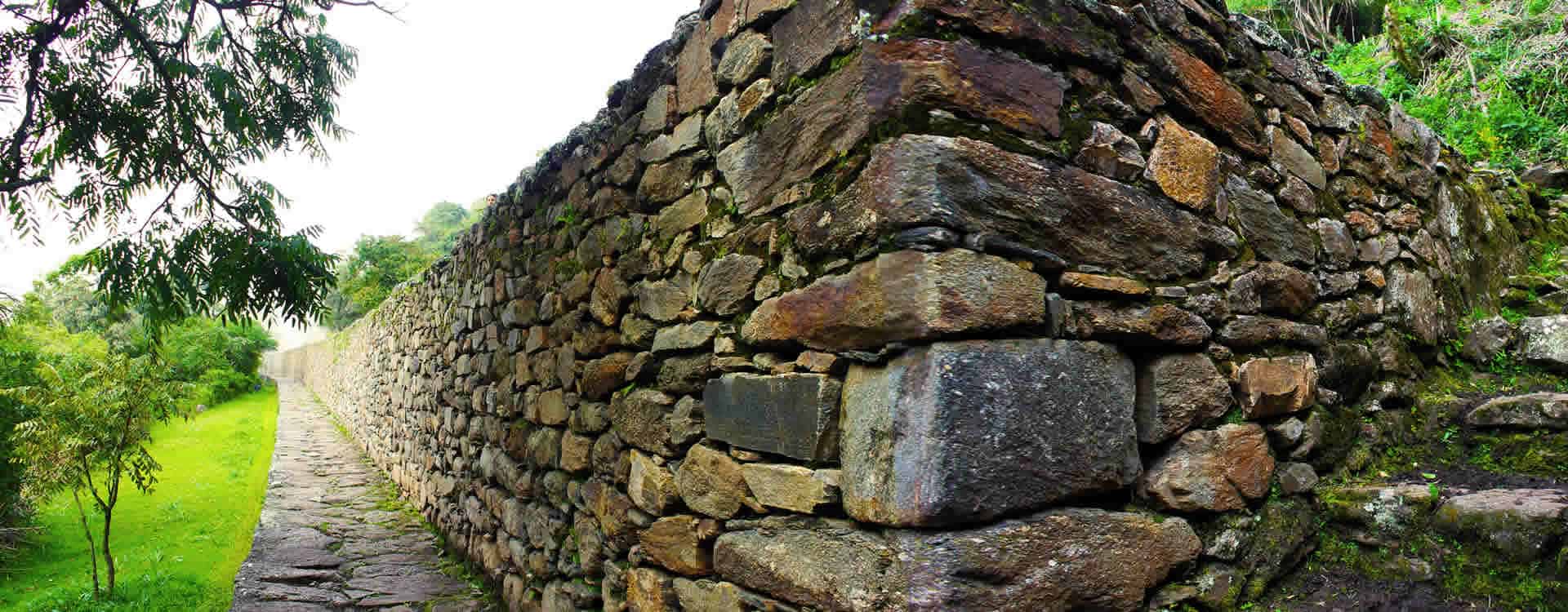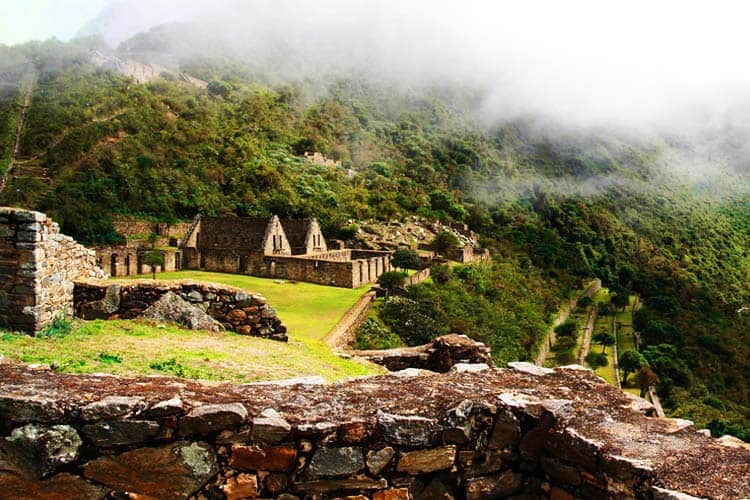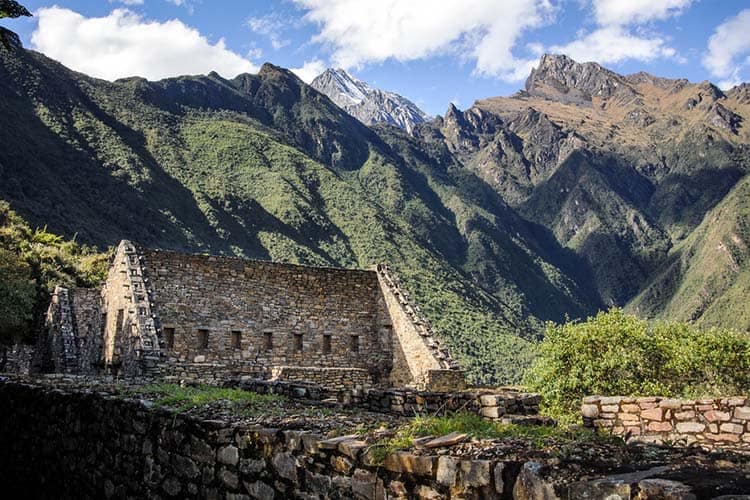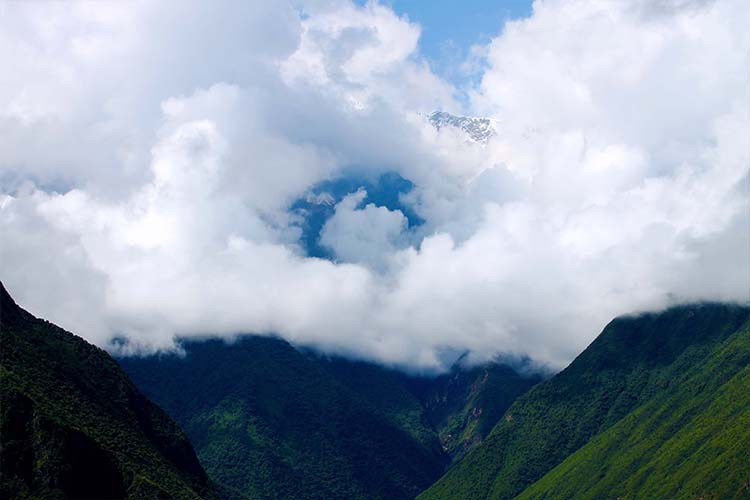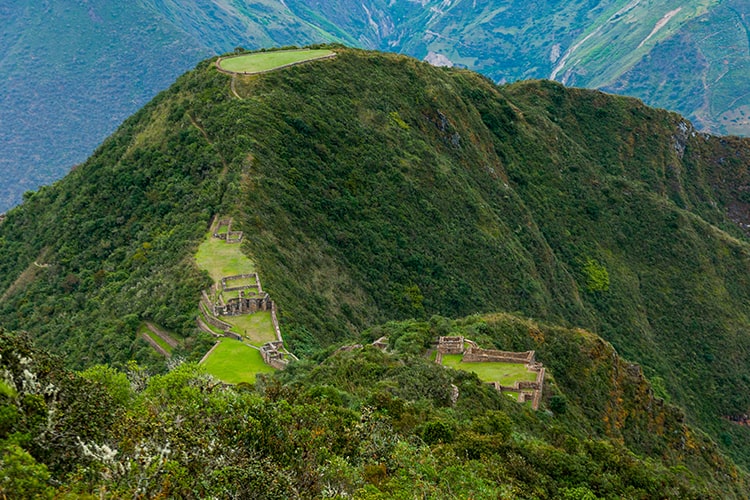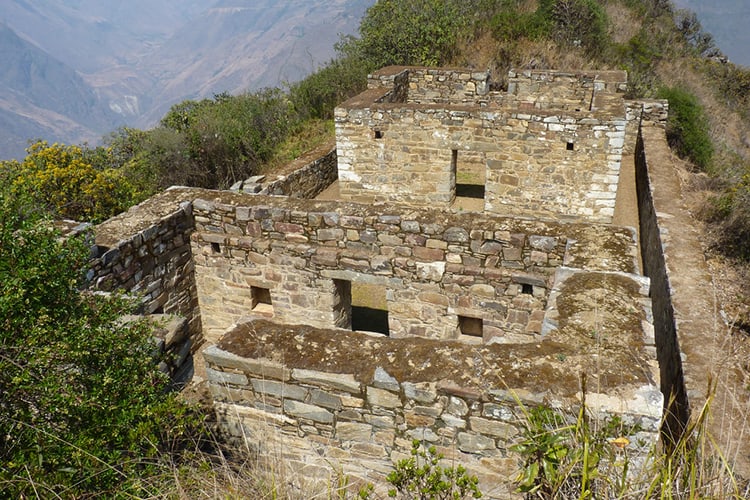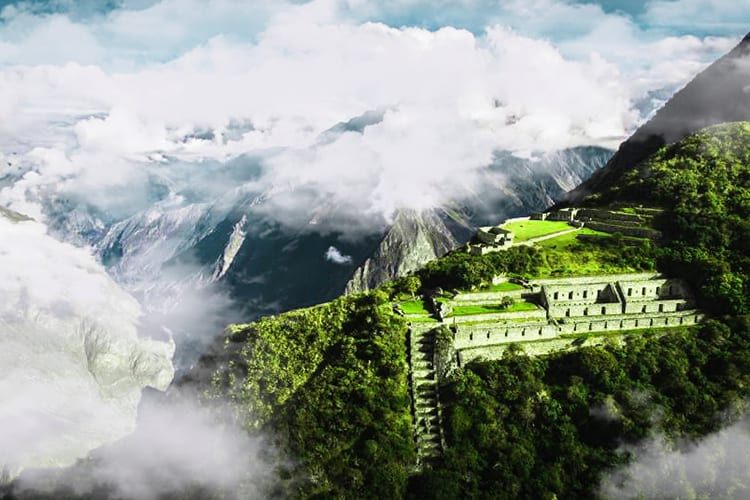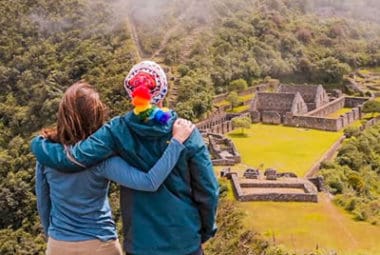Tour Details
Classic Tour Choquequirao Trek
- Day 1 – Qosqo , Cuzco City Tour.
- Days 2 – Cusco, Saywite, Cachora, Capuliyoc, Chiccisqa.
- Days 3 – Chiccisqa – Choquequirao Archaeological Site.
- Days 4 – Choquequirao – Santa Rosa.
- Days 5 – Santa Rosa, Cachora, Cusco.
- Days 6 – The Sacred Valley of the Incas.
- Days 7 – Machu Picchu Tour.
- Days 8 – Machu Picchu Tour.
- Days 9 – End of tour.
Itinerary
Classic Tour Choquequirao Trek 9 Days
Day 1 – Qosqo , Cuzco City Tour.
Upon arrival in Cuzco we will meet you and transfer you to you chosen hotel. Later in the day you will enjoy a Cuzco City Tour visiting the Inca fortress of Sacsayhuaman, the Cuzco cathedral in the main square and the most important temple of the Inca Empire, the Qoricancha, the Inca Temple of the Sun. Cusco is lovely city to wander around and you should take time to do this when not being guided.
In the afternoon we will pick you up from your hotel and we will start by visiting Cusco Cathedral which is one of the finest Colonial Cathedrals in the Latinamerica . Building started in 1560 and was completed in 1664. More than 90 years of sacrifice and effort Situated on the Plaza de Armas, the Cathedral owes many treasures, history and mysteries in the Plaza de Armas every year there are celebrations can be cultural can be religious Finally you visit Qoricancha (from the Quechua word Qori Qancha meaning (‘Temple of the Sun’).one of the most important temples of the Inca Empire, it was built to the Sun the father of the INCAS in the 17th century when Spanish arrived every temple was destroyed to the ground but QORICANCHA has survived and still stands to the eye of the world on the side of Qoricancha there is Santo Domingo church Priving to Tambomachay. Situated at 3.700 m of sea level a Quechua word ( Tampu machay ) the place where people can rest a short period of time. it could also be the bath of the Ñusta ( the Inca princess) it is also believed the sanctuary to the cult of water.
Next stop will be Puka Pukara Quechua word ( red fortress). This is an Inca archaeological site it was a military and administrative site it was built to control ,provide security and defend the Cusco city, as well as the control of the route to Calca that led to the Antisuyo (Forest County of the Inca).
The route then goes to the carved rocks of the Temple of the Moon and through the maze of rocks and tunnels of the Temple of the Monkey before arriving at Qenqo. is believed to be a multifunctional religious site was also a place of Andean worldview where nature converges and the space around us and astrological observatory, commissioned by people specifically looking for the seasons, the wise INKAS this archaeological site is unique, here the carving of many animals can be seen in high relief were considered secondary gods in the time of the Incas, and consists of rests formed by rocks with stairs in a zigzag, and a main building similar to a circular amphitheatre where 19 window sills are located as a way of seats.
You then move on to one of the most important Inca sites in South America, the enormous fortress of Sacsayhuaman. Scene of epic battles between Conquistadores and Incas, brave inka warriors protecting the citadel against the Spaniards, an ancient Inca story of Captain Cahuide he remained more than three days fighting the Spaniards killing one of the pizarro brothers, after having been alone and no one else around, Cahuide bravely threw himself in one of the towers to avoid being killed by the hands of the Spaniards. this cannot fail to impress.
While the high towers that once dominated the skyline were long since razed to the ground, the sheer scale of the zigzag stone walls is a sight to behold. Its construction took over seven decades and required the work of approximately 20,000 men.
The stone was dragged from 20 miles away and still today we are not quite sure how they moved the huge megaliths into place. Some of its external walls exceed 30 feet in height and the largest stone weighs over 350 tonnes.
From Sacsayhuaman we will head down to Cusco leaving you some time to wander these ancient streets, explore some more of the sites or just sit in a café on the Plaza de Armas and watch the world go by.
Day 2 – Cusco, Saywite, Cachora, Capuliyoc, Chiccisqa.
We depart Cusco early in a private car for a four hour drive to Cachora. We will visit the archaelogical site of Saywite before descending to the mountain village of Cachora, (2909m / 9543ft), a last minute opportunity to buy supplies. After lunch, it is a 2 hour hike to Capuliyoc (2915 metres/ 9561 feet) from where we have our first beautiful views of the Apurimac valley stretching below as well as the snow-capped peaks of Padrayoc and Wayna Cachora.
From here its a steep downhill descent for approximately 3 hours to our campsite.
- Distance Travelled: 19 km / 11.80 ml
- Approximate Walking Time: 6 hrs
- Accommodation: Camping at Chiccisqa (1836m / 6023ft).
Day 3 – Chiccisqa – Choquequirao Archaeological Site.
Departing early on the established trail, we descend to Playa Rosalinas and the magnificent Apurimac River (1550 metres/ 5084 feet) about 1 hour of hiking. We the begin our steep climb to Santa Rosa (2095m / 6873ft); where we can take a refreshing break, rest and buy water. We continue upwards, towards Marampata (2913m / 9557ft), a flat place where we can rest in similar conditions to Santa Rosa; enjoying a splendid view of Choquequirao.
This spot also has bathrooms and we will have lunch here. The climb from the river takes about 5 hours and is tough. From our lunch spot we can see the ruins of Choquequirao, from here we have two hours more hike to the ruins. (3110 metres/ 10120 feet) We will spend the late evening in the ruins, where we will watch the sunset and have the chance to see condors.
- Accommodation: Camping at Choquequirao campsite (bathrooms and cold water showers).
- Distance Travelled: 14 km / 8.69 ml.
- Approximate Walking Time: 7-8 hrs.
Day 4 – Choquequirao – Santa Rosa.
We have a chance to more fully explore the ruins and have a little rest in the morning. In the afternoon we return along the edge of the Apurimac canyon, descending to our tropical campsite at Santa Rosa. (5 hours hiking).
- Accommodation: Camping at Santa Rosa (2095m / 6873ft) Depending on the progress of the group, the guide may decide to camp at Chiccisqa (1836m / 6023ft).
Day 5 – Santa Rosa, Cachora, Cusco.
Early in the morning, in order to escape the heat of the canyon of the Apurimac, we descend to the raging river, and then begin an arduous climb that is rewarded with spectacular views. We climb for about four hours, and have lunch in Capuliyoc (2915 metres/ 9561 feet). The final two hours of our hike into the village of Cachora refreshingly flat through pretty farming countryside. Our private car will be waiting to take us back to Cusco (4 hours drive).
We will arrive in Cusco between 7and 8pm.
Day 6 – The Sacred Valley of the Incas.
After pick-up from your hotel today you will enjoy a full-day Sacred Valley tour, we will be visiting the Inca ruins of Pisac the market at Pisac a great place to buy souvenirs and then drive through the valley to the lovely Inca site and village at Ollantaytambo. You will have an English- speaking guide all day and a great buffet lunch included in the sunny valley. You will then spend the night down in the valley to take advantage of a change of scene, more oxygen (as you are 800 meters lower), and a shorter journey tomorrow on the train to Machu Picchu.
The archaeological complex of Pisac, it is located on hillside of pisaq This wonderful archeological site it is believed as a military, administrative and religious site a solid construction this cannot fail to impress you together with beautiful landscapes and of course you will have free time to take some photos.
Pisac Market Located 30 km from the city of Cusco, the main square of Pisac market houses , colorful and cheerful place, where the most famous Cusco Andean handicrafts made by hands are exhibited, including crafts, projecting pieces textiles, ponchos bags, etc. handicrafts and ceramics, which are reproductions of Inca archaeologies parts like stocks ( ceremonial glasses ), necklaces, etc.
To this fair traders and artisans of many indigenous peoples, dressed in their costumes. Chinchero We will visit the picturesque Andean village of Chinchero where royal hacienda of Tupac Inca Yupanqui remains. Admire its well preserved Inca Wall at the Main Square, visit the beautiful colonial temple with interesting frescoes on the portico, built on the foundations of an Inca building. Ollantaytambo Lunch at a local restaurant in the Sacred Valley of the Incas. In the afternoon we visit the fortress and citadel of Ollantaytambo, built to guard the entrance to this part of the valley and protect it from possible invasion from the tribes of the jungle.
We will have the opportunity to walk the streets of the town and have a clear idea of what this military, religious and agricultural center during the Inca Empire was. We h4ly recommend to spend the night down in the valley as we getting close to machu picchu for the next day, and there is more oxygen as you are 800 meters lower.
Day 7 – Machu Picchu Tour.
Today you may have an early start to catch your chosen train to Machu Picchu which will be one of the services described in the link below. The advantage you have is that you have stayed in the valley overnight and therefore don ́t have to get up as early as you would in Cuzco to catch the train.
A transfer will pick you up from your hotel and take you to the station or if you are staying in one of the hotels really close to, or in the station itself, you can walk there.
Day 8 – Machu Picchu Tour.
After being met in Aguas Calientes by your guide you will then have a full day tour. The name Machu Picchu translates as ‘Old Mountain’, in contrast to the nearby peak of Huayna Picchu which means “Young Mountain”. Constructed by the Inca Pachacutec in the 15th Century, it was mysteriously abandoned 100 years later during time of the Spanish conquest. It is generally believed that it was never discovered by the Spanish and simply disappeared into the jungle, hidden from western eyes until it was “discovered” by Hiram Bingham in 1911. He arrived with the help of local people who knew of its existence, and indeed there was actually a family living and farming amongst the ruins.
You will enjoy a tour of Machu Picchu led by a qualified English speaking guide before having some free time to explore the site by yourselves. Your guide will lead you on a full exploration of the ruins – staircases, terraces, temples, palaces, towers, fountains and the famous sundial.In the afternoon, you will head back to Machu Picchu train station for the departure of your train.
You will be met at the train station and returned to your hotel in Cusco.
Day 9 – End of tour.
End of tour
Included
What is included?
- pick snd transfer from airport to hotel
- all pick ups from all ports or hotels
- entrance tickets to machupicchu
- buses up and down
- Pre-departure briefing: You will meet your guide and group in our office for an orientation to the trek and we will provide you the duffle bags which will be carried by our porters or horses depending what destination you are hiking. The meeting will be at 6:00 PM the evening before your trip begins.
- Transport: pick up from your hotel in the morning and transportation in a private vehicle to the starting point of the trek.
- English speaking tour guide ,
- Personal tents: 2 people stay in each 4-person tent to allow for higher comfort and luggage security.
- Camping equipment: Dining and kitchen tents, tables, chairs, and all cooking equipment (carried by porters or horses ).
- 01 Duffle bag: You can put your personal belongings (up to 5 kilos/11 lbs), includes your sleeping bag, in here to be carried by the porters or horses.
- Accommodation: nights in tents
- Porters: We include your personal porter who is responsible for carrying your duffel with your personal items (up to 5 kilos/11 lbs). There is no additional fee for this. We will give you your duffel bag at the briefing the night before, and this should be filled with the things you need for night and the next day. You will not have access to your duffel until you arrive at the evening campsite.
- Trekking Cook: A chef specialized in cooking on the trail, with an assistant, will prepare all of your delicious meals along the journey .
- Meals: 3 Breakfasts, 3 Lunches, 3 dinners and Snacks (Vegetarian, vegan or special menus are available at no extra cost)
- Wake up tea: Every morning at the campsite, you will woken up with a cup of coca tea! Our staff will bring the tea to your tent so that you will be warmed from inside out before you start your day.
- Tea time: Every afternoon before dinner, the cooks will provide popcorn, biscuits, coffee, hot chocolate, teas, hot water, etc. After a long day of hiking, you will not have to wait until dinner to relax, warm up, and enjoy a bite to eat!
- Daily snacks – Days 1, 2 and 3: Our snacks consist of local fruits, biscuits, chocolate, caramels, etc. We will give this snack to you at the beginning of each day in your cloth bag.
- Medical kit: Our crew will bring a first-aid kit, including emergency oxygen bottle.
- Train tickets: From Cuzco to Aguas Calientes and viceversa . (subject to availability)
- Transport: Private transport from hotel to train station and viceversa
- 24-hour guest service: We have telephone service available 24 hours/day for ease of communication and preparation with the agency leading up to your trek.
Not included:
- Sleeping Bags: You can rent one from our company if you do not have your own. Our sleeping bags are effective and durable to protect from temperatures as low as -18ºC (0ºF). They are mummy form and include a sleeping liner. The bags are cleaned after every use
- Walking Sticks: You can rent a set from our company if you would like.
- Last Day: Lunch and Dinner in Aguas Calientes.
- Personal clothing and gear
- Travel insurance
- Tips for our staff
- Additional costs or delays out of control of the management (landscape, bad weather condition, itinerary modification due to a safety concern, illness, change of government policy, political instability/strike, etc.)
- all meals which is not specified
- all entrances to inka sites


